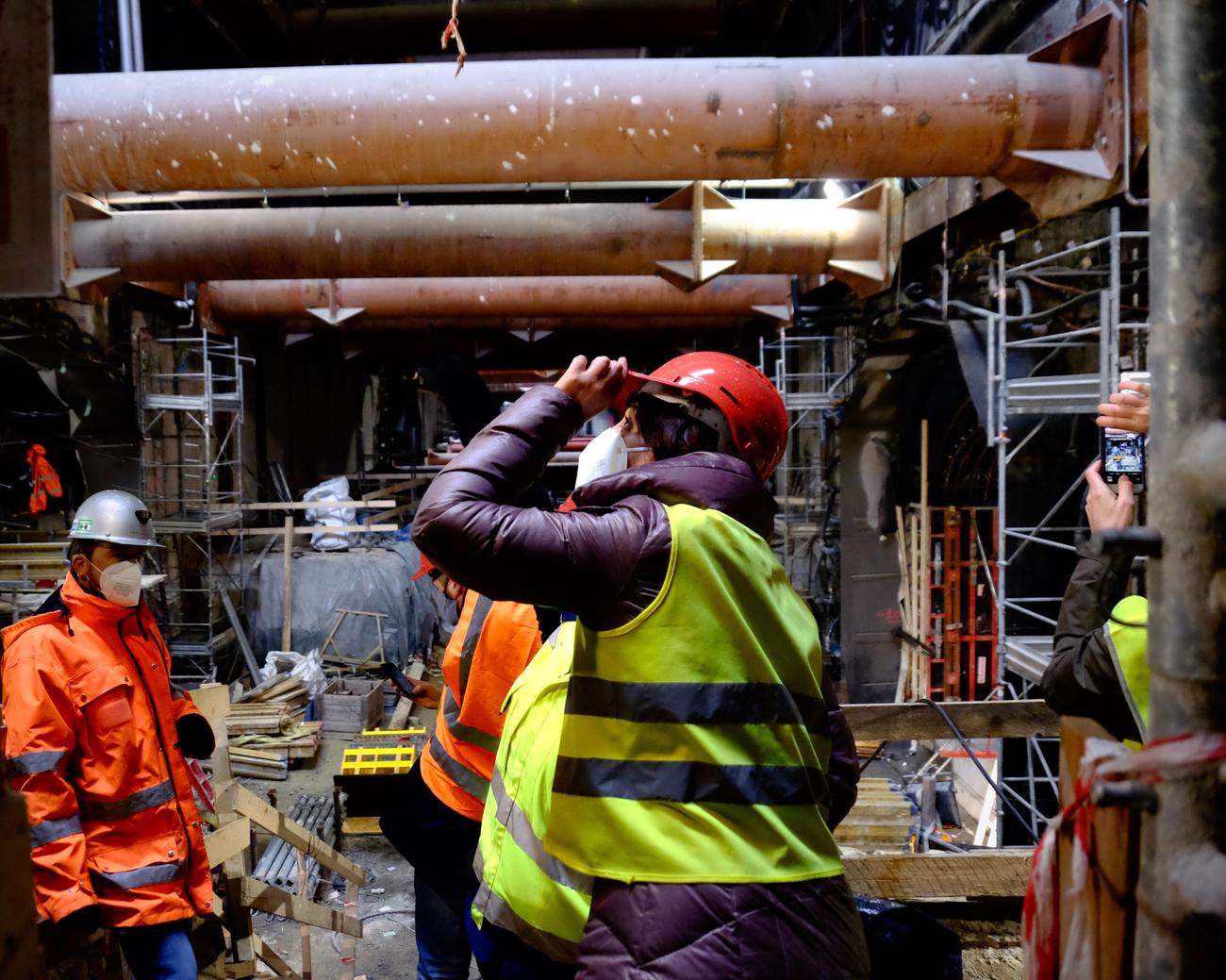Unveiling the Linguistic Journey: Why Is a Crane Called a Crane? Imagine the awe-inspiring sight of a crane, its graceful wings stretching across the sky, its slender body soaring effortlessly through the air. Now, envision a powerful construction machine, capable of lifting gargantuan loads, towering above buildings in a display of sheer strength. What connects these two seemingly disparate entities? How did a majestic bird come to lend its name to a colossal piece of construction equipment? Delving deep into the annals of etymology and linguistic evolution, we embark on a captivating exploration of the enigmatic history behind why a crane—a magnificent avian symbol of grace— shares its name with a powerhouse of modern engineering. Join us as we unravel the intricate tale of how words evolve through time, connecting the dots to reveal the fascinating journey that brought us the name ‘crane.’

Why is a crane called a crane?
Ever wondered why a towering, powerful construction equipment is called a crane? It turns out that the name “crane” has a fascinating origin rooted in the bird kingdom. Cranes are named after the majestic bird, and the reason lies in their resemblance to the long neck and beak of a standing bird. Just like the bird gracefully extends its neck to reach high branches, the crane machine extends its arm to lift heavy objects to great heights.
But the linguistic journey of the word “crane” doesn’t stop there. Let’s delve into the intriguing history and evolution of this word, connecting the dots and unraveling its meaning.
To understand the path “crane” took to become synonymous with powerful construction equipment, we need to go back in time to ancient Mesopotamia, modern-day Iraq. Around 3000 BC, the first crane machine, known as the shadouf, was invented. The shadouf was used to lift water for irrigation and featured a long beam with a bucket attached to one end and a counterweight on the other. Although not as sophisticated as modern cranes, the shadouf laid the foundation for this incredible invention.
Fast-forward to ancient Greece and the Roman Empire, where construction cranes started making their appearance. These early cranes were mainly made of wood, reflecting the materials available at the time. The power for these machines was initially provided by the physical exertion of humans or animals. Can you imagine the incredible strength and effort required to operate those early cranes?
But as civilization advanced, so did the technology. With the advent of the Industrial Revolution, materials like cast iron, iron, and steel became more readily available. This allowed for the construction of larger and more robust cranes capable of handling heavier loads. Steam engines entered the scene, revolutionizing the power source for cranes in the 18th or 19th century.
Today, cranes come in various types and sizes, each serving a specific purpose. We have mobile cranes, including truck-mounted and rough-terrain cranes, which offer flexibility and mobility. Loader cranes are specialized machines designed for transporting materials and assembling heavy equipment. Tower cranes, with their towering presence on construction sites, help construct high buildings with precision.
The incredible lifting capacity of modern cranes is made possible through hydraulic systems, internal combustion engines, and electric motors. These technological advancements have propelled cranes to new heights, quite literally.
In conclusion, the naming of cranes as we know them today is a testament to the power of language and its connection to the world around us. From the resemblance to the majestic bird to the evolution of the machine itself, the word “crane” has withstood the test of time. So, the next time you see a crane on a construction site, take a moment to appreciate the fascinating linguistic journey that brought this name to life.
“The naming of cranes aligns the towering strength of the construction machine with the elegance and grace of its avian namesake.”
Cranes are fascinating creatures that have captivated our curiosity for centuries. If you’re curious to learn some intriguing and mind-blowing fun facts about cranes, click here! You’ll discover a world of astonishing information about these majestic birds and gain a new appreciation for their grace and beauty. So, don’t miss out on this opportunity to expand your knowledge and satisfy your thirst for excitement. Click this link to delve into the mesmerizing world of fun facts about cranes: fun facts about cranes
The Unique Bond: How Walnut the White Nape Crane Found Love with Her Keeper
[youtube v=”ihla4rV3Ckc”]
Introduction
In the enchanting world of cranes, where territorial displays and signs of aggression reign supreme, there is a heartwarming tale that unfolds. Meet Chris Crow, an animal keeper with the Smithsonian Conservation Biology Institute in Front Royal, Virginia. And then, there’s Walnut, a beautiful and endangered white nape crane. Bound together by a remarkable connection, their story showcases the power of human care and dedication to the survival of a species.
Imprinting on People: Walnut’s Unusual Journey
Walnut’s journey began when she was hand-raised by people at another zoo, causing her to socially bond with humans instead of her fellow cranes. Her inability to get along with other cranes raised concerns about her ability to breed naturally. Intrigued by her unique circumstances, the decision was made to bring her to the institute for further care and attention.
A Man-Made Solution to a Man-Made Problem
As cranes face the looming threat of habitat destruction, hunting, and poaching, Chris believes that the solution to their declining population should be man-made as well. To safeguard these magnificent creatures, the institute breeds endangered birds in captivity, contributing to the growth of their population. The aim is to provide an alternative in case their wild counterparts continue to dwindle.
An Unconventional Bond: Mating with a Human Companion
Due to her imprinting on humans, Walnut has formed a unique bond with Chris. Mistaking Chris as her mate, Walnut engages in courtship displays and even solicits him to mate with her. Recognizing this opportunity, Chris devised a plan to mate Walnut naturally. By harvesting fertile eggs and placing them in the nests of other crane pairs, the chicks are then raised by their avian parents instead of humans. This unconventional method has resulted in Walnut successfully fathering seven chicks, two of whom have gone on to breed and carry the species forward.
“Walnut has had seven chicks, two of them have gone on to pair with other cranes and breed naturally and have chicks of their own.”
A Goofy Story with a Serious Message
While many people find amusement in the quirky tale of Walnut and Chris, there is a deeper message it conveys. Their story sheds light on the plight of these endangered animals, created solely due to human actions. The destruction of crane habitats, along with hunting and poaching, has pushed them to the brink of extinction. By sharing this eccentric tale, Chris hopes to grab people’s attention and drive them to take action for the conservation of these magnificent birds.
“In general, it’s just a goofy story that hopefully will get people’s attention towards the plight of these animals.”
Conclusion
Walnut’s captivating story showcases the profound impact of human care and compassion on the survival of endangered species. Through her unique bond with Chris, she has become a symbol of resilience and hope for cranes worldwide. As the world grapples with the consequences of its actions, it is imperative that we recognize our role in both the decline and revival of these remarkable creatures. Together, we can rewrite their future and ensure that the magnificence of cranes continues to grace our skies for generations to come.

FAQ
Q: Why is a crane called a crane?
A: Cranes are named after the bird due to their resemblance to the long neck and beak of a standing bird.
Q: What is the history of cranes?
A: The first crane machine was the shadouf, invented in Mesopotamia (modern Iraq) around 3000 BC, which was used to lift water for irrigation. Construction cranes appeared in ancient Greece and larger cranes were developed in the Roman Empire. Early cranes were made of wood, but cast iron, iron, and steel became more common during the Industrial Revolution.
Q: How do cranes work?
A: Cranes are complex machines made up of simple machines like pulleys and levers. They are used for lifting and moving heavy objects, transporting materials, and assembling heavy equipment. Modern cranes use internal combustion engines or electric motors and hydraulic systems to increase lifting capacity.
Q: What are the different types of cranes?
A: There are various types of cranes, including mobile cranes (such as truck-mounted and rough-terrain cranes) and loader cranes. There are also different sizes of cranes, ranging from small jib cranes for workshops to tall tower cranes for constructing high buildings. Mini-cranes are also used for specific purposes.
Q: How has the technology of cranes evolved over time?
A: Initially, power for cranes was provided by the physical exertion of humans or animals, but steam engines were introduced in the 18th or 19th century. Nowadays, modern cranes use internal combustion engines or electric motors and hydraulic systems to increase lifting capacity.
- Senior at What Age: Benefits & Eligibility Guide - March 29, 2025
- Unlocking Senior Benefits: How Old is a Senior? Your Complete Guide - March 29, 2025
- Master Russian Politeness:A Guide to Saying Please - March 29, 2025
















